Annual Report of Domestic Oil and Gas Reserves (County Level Report)
Oil and Gas Reserves System Surveys
201X EIA-23S Instructions
Annual Report of Domestic Oil and Gas Reserves (County Level Report)
OMB: 1905-0057
|
U.S. DEPARTMENT OF ENERGYEnergy Information Administration Office of Oil and Gas Washington, DC 20585 |
OMB Number: 1905-0057 Expiration Date: xx/xx/xxxx Version
No.: xxxx.xx |
ANNUAL REPORT OF DOMESTIC OIL AND GAS RESERVES
FORM
EIA-23S
Summary Level Report Instructions
SURVEY YEAR 201X
Table of Contents
Page
General Instructions 2
A. Purpose 2
B. Who Must Submit Form EIA-23S 2
C. When and Where to Submit 2
D. Record Keeping Requirements 2
E. Sanctions 2
F. Disclosure of Information 2
G. Reporting Standards 3
1. Proved Reserves 3
2. Survey Year Production 3
3. Total Operated Basis 3
4. States and Geographic Subdivisions 3
5. Reporting Units 3
6. EIA Secure File Transfer Information……………………….. 4
Specific Instructions 5
H. Cover Page - Operator Identification 5
I. Summary Report 5
J. Definitions 6
For Information, Assistance, or Additional Forms
Contact the EIA-23 Coordinator 800-879-1470
8:00 a.m. – 4:30 p. m. Central Time
GENERAL INSTRUCTIONS
A. PURPOSE
The Energy Information Administration (EIA) of the Department of Energy (DOE) seeks, with Form EIA-23S, to gather and summarize credible and timely data regarding proved reserves and production of crude oil, natural gas, lease condensate, and other related matters. The Government will use the resulting information to develop national and regional estimates of proved reserves of domestic crude oil, natural gas, and natural gas liquids and to facilitate national energy policy decisions.
B. WHO MUST SUBMIT FORM EIA-23S
Each operator (Section J Definitions, page 6) of domestic oil and/or gas wells as of December 31, 201X that has been selected must file either a Form EIA-23S or a Form EIA-23L.
Filing requirements are based on operator category or size, which is determined by the total or gross (8/8ths) annual operated production rate. Production refers to the total calendar year production from all domestic oil and/or gas wells operated on December 31, 201X, including wells abandoned during the year.
If you have received the EIA-23S Summary Level Report form, but your total gross operated production exceeds 400 thousand barrels (400 MBbls) of crude oil or 2 billion cubic feet (2,000 MMCF or 2 BCF) of natural gas, or you operate wells in the federal offshore or coalbed methane gas wells, contact the EIA-23 Coordinator 800-879-1470 to obtain the EIA-23L County Level Report form and instructions.
Note that as defined, day-to-day physical operation of a well or wells does not alone qualify a person as the operator. Physical operation may occasionally be divorced from operatorship, such as in the instance of manipulation of swing wells by a gas pipeline company representative or the manipulation and maintenance of wells located on an offshore platform by the platform manager. While the operator's own personnel usually perform such duties, the key factor is that the operator is the person who makes management decisions regarding the well(s) in question on behalf of the owner(s).
If you are not certain whether you are the operator, contact the EIA-23 Coordinator 800-879-1470 for assistance in making this determination. If you are not the operator of oil and/or gas wells on December 31, 201X (perhaps a former operator or solely a working or royalty interest owner), you should complete and sign the Cover Page only and return it to EIA along with a letter stating when operations ceased and what became of the wells you previously operated.
C. WHEN AND WHERE TO SUBMIT
The completed 201X survey forms must be submitted on or before June 15, 201Y. Filing electronically, using Secure File Transfer or Fax, is encouraged.
Secure File Transfer: See page 4 for information
Fax completed forms to: 202 586-1076
Mail completed paper forms to:
Oil and Gas Surveys
U. S. Department of Energy, EIA
Ben Franklin Station
PO Box 279
Washington DC 20044-0279
When entering responses on hard copies, type or print in black ink using all capital letters. EIA-23S forms and instructions are available on the EIA website.
For information concerning requests for extension of time to file or for exception from filing Form EIA-23S, contact the EIA-23 Coordinator 800-879-1470 from 8:00 a.m. to 4:30 p.m. Central Time.
D. RECORD KEEPING REQUIREMENTS
All records necessary to reconstruct the data on this form must be retained and available for a period of three (3) years from the filing due date.
E. SANCTIONS
The timely submission of Form EIA-23S by those required to report is mandatory under Section 13 (b) of the Energy Information Administration Act of 1974 (FEAA) (Public Law 93-275), as amended. Failure to respond may result in a civil penalty of not more than $2,750 a day for each violation, or a fine of not more than $5,000 a day for each willful violation. The government may bring a civil action to prohibit reporting violations that may result in a temporary restraining order or a preliminary or permanent injunction without bond. In such civil action, the court may also issue mandatory injunctions commanding any person to comply with these reporting requirements.
F. DISCLOSURE OF INFORMATION
The annual production of crude oil, lease condensate, and natural gas reported on Form EIA-23 are considered public information. These data elements may be released in company-identifiable form and will not be protected from disclosure in identifiable form when releasing statistical aggregate information. All other information reported on Form EIA-23 will be protected and not disclosed to the public to the extent that it satisfies the criteria for exemption under the Freedom of Information Act (FOIA), 5 U.S.C. §552, the DOE regulations, 10 C.F.R. §1004.11, implementing the FOIA, and the Trade Secrets Act, 18 U.S.C. §1905.
The Federal Energy Administration Act requires the EIA to provide company-specific data to other Federal agencies when requested for official use. The information reported on this form may also be made available, upon request, to another component of the Department of Energy (DOE); to any Committee of Congress, the Government Accountability Office, or other Federal agencies authorized by law to receive such information. A court of competent jurisdiction may obtain this information in response to an order. The information may be used for any non-statistical purposes such as administrative, regulatory, law enforcement, or adjudicatory purposes.
Disclosure limitation procedures are applied to the protected statistical data published from EIA-23 survey information to ensure that the risk of disclosure of identifiable information is very small.
Confidential information collected on Form EIA-23 will be provided to United States Department of Interior offices (the Bureau of Ocean Energy Management and the United States Geological Survey) for statistical purposes only, in conducting their resource estimation activities.
G. REPORTING STANDARDS
Proved Reserves
EIA recognizes that the judgment of geologists and petroleum engineers is required in the reserve estimation process, and that as a result, proved reserves are estimates rather than precise quantitative measurements.
Proved reserves of oil and gas as of December 31, 201X are the estimated quantities of oil and/or gas, which geological and engineering data demonstrate with reasonable certainty to be recoverable in future years from known reservoirs under existing economic and operating conditions. (See Proved Reserves, Crude Oil; Proved Reserves, Natural Gas; and Proved Reserves, Lease Condensate, Section I Definitions, page 9.)
Survey Year Production
Production data are required from all operators. If the actual production data are not available at the time Form EIA-23S is prepared, estimate production.
If any properties were acquired during the survey year, production data from the acquired properties should be reported from the date of purchase. If any properties were sold during the survey year, production data should be reported until the date of sale.
Total Operated Basis
All data on Schedule A (reserves and related data by field) are to be reported on an 8/8ths or Total Operated Basis. When reporting on this basis, production and reserves data for any properties on which operations were acquired during the survey year should be reported from the date of transfer or purchase. If any properties were sold or transferred to a new operator during the survey year, production and reserves data should be reported until the date of sale or transfer.
Examples:
Of the total 8/8ths interest, respondent's share is 50 percent and the associated royalty share is 6.25 percent. Respondent operates property. Respondent reports 100 percent of proved reserves and production.
Of the total 8/8ths interest, respondent's share is zero but it operates the property (i.e., a contract operator). Respondent reports 100 percent of proved reserves and production.
States and Geographic Subdivisions
To determination in which state or geographic subdivision to report proved reserves and production data is based on the location of the field(s) containing the oil and/or gas. If a field overlaps two or more states or subdivisions, the proved reserves data must be subdivided into the appropriate geographic components.
For a State in which you operated but not listed on the form, specify the two-letter postal code in the line labeled "Other States". Enter the production and reserves in Columns A through I.
Offshore proved reserves data are required separately for the State and Federal domains. If an offshore field lies on or between disputed boundaries, include all data in the State offshore area.
Reporting Units
Volumes must be reported in whole numbers and not contain decimals. All volumes are to be reported in the appropriate reporting units as shown below:
a. Crude Oil: All crude oil volumes are to be reported in thousands of barrels (MBbls) (42 U.S. gallons per barrel at atmospheric pressure corrected to 60° Fahrenheit) and excluding basic sediment and water.
b. Natural Gas: All natural gas volumes are to be reported in millions of cubic feet (MMCF) at 14.73 psia and 60° Fahrenheit, wet after lease separation.
It is recognized that the operator in many instances has no knowledge of the ultimate reduction of the gas stream produced from his properties, which may result from further downstream processing. The operator is requested to report volumes of natural gas, which remain after processing through lease and field separation facilities. Lease use and flared and vented gas are also considered production and should be included in the volumes reported.
EIA obtains data from gas processing plants separately. Gas volumes reported on Form EIA-23S must not be corrected for liquids removed by these plants. If you do not know if a field facility through which your gas is processed is currently reporting data to EIA or not, contact the EIA-23 Coordinator to obtain information on those plants which report.
c. Lease Condensate: All lease condensate volumes are to be reported in thousands of barrels (MBbls) (42 U.S. gallons per barrel, at atmospheric pressure corrected to 60° Fahrenheit).
d. Rounding: Round liquid volumes 500 barrels and above up to ‘1’ MBbls, and less than 500 barrels down to ‘0’ MBbls. Round gas volumes 500 MCF and above up to ‘1’ MMCF, and less than 500 MCF down to ‘0’ MMCF.
e. Negative and Positive Volumes: All data are to be entered as whole number integers without plus (+) or minus (-) symbols.
EIA Secure File Transfer Information
EIA is ensuring the security of your transactions by using the latest Internet security technology. The technology being used to protect your data is encryption which is the scrambling of data into a code that is unreadable to anyone who does not have the key that deciphers it. The secure hypertext transfer protocol (https) is a communications protocol designed to transfer this encrypted information between computers over the World Wide Web. All information is protected by 128-bit encryption to maintain the privacy and confidentiality of your data. The only thing you need to take advantage of strong encryption technology is a secure browser, one that supports 128-bit encryption.
To use the EIA https secure file transfer system:
Click to open the SFT webpage
or
type in the URL in your browser:
https://signon.eia.doe.gov/upload/noticeoog.jsp
The EIA SFT Notice to Users page appears.
Read and then click the Accept button.
The
Secure File Transfer System page appears.
At the bottom of this page, in blue text, click on Instructions for Secure File Transfer.
If you have any trouble transferring your files, please call the EIA User Services Center 202-586-8959 or email them at [email protected].
SPECIFIC INSTRUCTIONS
H. COVER PAGE - Operator Identification
You are required to enter those items that are incorrect or missing from the preprinted form.
Part I. Identification
EIA Operator ID Code: If this item is missing, contact the EIA-23 coordinator.
Operator Name, Address, City, State, Zip Code. Enter the legal name and address of the operator. If a foreign address, enter city, local equivalent of State name (e.g., province), and country.
Item 1: Contact Information. Name, telephone number, fax number, and e-mail address of the person most knowledgeable about the reported data. This person should be familiar with the data provided, and will be the person to whom inquiries will be directed, if necessary.
Item 2: Was your company an oil and gas field operator ...? Check the appropriate box and follow the instructions for completing the rest of the form.
Item 3: Company Status, Name, and/or Address Change or Correction. If there was a change to the company name or address, or if the company was sold, merged with another company or the company went out of business, check the appropriate box and complete Item 4.
Item 4: Note Change Company Name, Address, and/or Contact Information. If any box in Item 3 was checked, enter the new or correct company name, address, or contact person here.
Part II. Approval
Items 5 thru 8: Approval - Enter the name and title of the individual designated by the respondent company to review
and approve the accuracy of this submission and the date of the signing. This report should be reviewed and approved by a responsible officer or the office responsible for regulatory filings. If filed electronically, there is no requirement to submit a signed cover page.
I. SUMMARY REPORT
SECTION 1.0: Operator Detailed Data Report
Item 1.1: EIA Operator ID Code – This is the same as the Cover Page EIA Operator ID Code.
Item 1.2: Operator Name - This is the same operator name on the Cover Page. Enter the first 35 characters of the operator name. If the name exceeds 35 characters, do not abbreviate, but simply truncate the extra characters from the right.
Item 1.3: Original - Enter an ‘X' in the box if this is the first submission of this schedule for the survey year. Otherwise leave blank.
Item 1.4: Amended - Enter an ‘X' if this schedule amends a previously submitted schedule. Otherwise, leave blank.
SECTION 2.0: Reserves and Production Data
Provide data in Columns A through I for each State or geographic subdivision in which you were an operator of oil and/or gas wells as of December 31, 201X. Proved reserves and production for 201X are to be reported on a Total Operated Basis. (See Section G, Reporting Standards)
You are not required to complete entries with zeros for states or subdivisions in which you do not operate wells. Leave these entries blank.
REPORTING INSTRUCTIONS
201X Reserves Data
December 31, 201X Proved Reserves Data - Enter estimates of total proved reserves for operated properties if estimates are available. The estimates should be based on your most recent evaluations, adjusted for production through December 31, 201X, and for any other relevant factors. If reserves were depleted during 201X, enter zero. The resulting estimates for reserves should be consistent with the definitions of proved reserves. (See Section J, Definitions, page 6)
Column A: Crude Oil Reserves
Column D: Natural Gas Reserves
Column G: Lease Condensate Reserves
Note: If no proved reserves estimates are available, enter "NA" in Column(s) A, D, and/or G.
201X Production Data
December 31, 201X Production Data are required from all operators. If the actual survey year production data are not available at the time the Form EIA-23S is prepared, estimate production. Lease use and flared and vented gas are also considered production and should be included in the volumes reported.
Production from Properties With Reserves Estimated: Enter the 201X production for those operated properties with proved reserves data that were reported in Columns A, D, or G in the corresponding Columns B, E, or H.
Column B: Crude Oil Production
Column E: Natural Gas Production
Column H: Lease Condensate Production
Production from Properties for Which Reserves Were NOT Estimated: Enter the 201X production for those operated properties for which proved reserves estimates are NOT available in existing company records and were therefore NOT reported in Columns A, D or G.
Column C: Crude Oil Production
Column F: Natural Gas Production
Column I: Lease Condensate Production
U.S. TOTALS: Sum the entries in each column and enter the totals on the last line of page 2, U.S. Totals.
J. DEFINITIONS
These definitions have been formulated with reference to the particular purposes of Form EIA-23S. They are not necessarily synonymous with the same or similar terms used in DOE regulations, and are not to be construed as definitions applicable for any purposes other than the collection and reporting of data on Form EIA-23S.
Affiliated (Associated) Company: An entity that is directly or indirectly owned, operated, or controlled by another entity. (See Person and Control)
Control: The term control (including the terms controlling, controlled by, and under common control with) means the possession, direct or indirect, of the power to direct or cause the direction of the management and policies of a person, whether through the ownership of voting shares, by contract or otherwise. (See Person)
Crude Oil (excluding Lease Condensate): A mixture of hydrocarbons that exists primarily in the liquid phase in natural underground reservoirs and remains liquid at atmospheric pressure after passing through surface separating facilities. Such hydrocarbons as lease condensate and natural gasoline recovered as liquids from natural gas wells in lease or field separation facilities and later mixed into the crude stream are excluded. Depending upon the characteristics of the crude stream, it may also include:
small amounts of hydrocarbons that exist in gaseous phase in natural underground reservoirs but are liquid at atmospheric pressure after being recovered from oil well (casinghead) gas in lease separators and are subsequently commingled with the crude stream without being separately measured
small amounts of non-hydrocarbons produced with the oil, such as sulfur and various metals.
When a State regulatory agency specifies a definition of crude oil which differs from that above, the State definition is to be followed.
Field Separation Facility: A surface installation designed to recover lease condensate from a produced natural gas stream usually originating from more than one lease, and managed by the operator of one or more of these leases. (See Lease Condensate)
Gross Working Interest Ownership Basis: Gross working interest ownership is the respondent's working interest in a given property plus the proportionate share of any royalty interest, including overriding royalty interest, associated with the working interest. (See Working Interest and Royalty Interest {Including Overriding Royalty})
Lease Condensate: A mixture consisting primarily of pentanes and heavier hydrocarbons which is recovered as a liquid from natural gas in lease or field separation facilities. This category excludes natural gas plant liquids, such as butane and propane, which are recovered at downstream natural gas processing plants or facilities. The output of natural gas processing plants is reported on Form EIA-64A, Annual Report of the Origin of Natural Gas Liquids Production and Form EIA-816, Monthly Natural Gas Liquids Report.
Lease Separator: A facility installed at the surface for the purpose of separating gases from:
produced crude oil and water at the temperature and pressure conditions of the separator, and/or
that portion of the produced natural gas stream, which liquefies at the temperature and pressure conditions of the separator.
Natural Gas: A gaseous mixture of hydrocarbon compounds, the primary one being methane. The parameters for measurement are cubic feet at 60 degrees Fahrenheit and 14.73 pounds per square inch absolute (psia). The Energy Information Administration measures wet natural gas and its sources of production, associated/dissolved natural gas and non-associated natural gas, and dry natural gas, which are produced from wet natural gas. This EIA survey does not include landfill gas (biomass gas), synthetic natural gas, coke oven gas, or manufactured gas.
Wet natural gas: A mixture of hydrocarbon compounds and small quantities of various non-hydrocarbons existing in the gaseous phase or in solution with crude oil in porous rock formations at reservoir conditions. The principal hydrocarbons normally contained in the mixture are methane, ethane, propane, butane, and pentane.
Typical non-hydrocarbon gases that may be present in reservoir natural gas are water vapor, carbon dioxide, hydrogen sulfide, nitrogen and trace amounts of helium. Under reservoir conditions, natural gas and its associated liquefiable portions occur either in a single gaseous phase in the reservoir or in solution with crude oil and are not distinguishable at the time as separate substances. Note: The Securities and Exchange Commission and The Financial Accounting Standards Board refer to this product as natural gas.
Dry natural gas: Natural gas that remains after:
the liquefiable hydrocarbon portion has been removed from the gas stream (i.e., gas after lease, field and/or plant separation)
any volumes of non-hydrocarbon gases have been removed where they occur in sufficient quantity to reduce the gas quality below minimum pipeline specifications (rendering it unmarketable).
Natural Gas Processing Plant: Facilities designed to recover natural gas liquids from a stream of natural gas that may or may not have passed through lease separators and/or field separation facilities. These facilities also control the quality of the natural gas stream to be marketed. Cycling plants are classified as natural gas processing plants.
Operator: The person responsible for the management and day-to-day operation of one or more crude oil and/or natural gas wells as of December 31, 201X. The operator is generally a working interest owner or a company under contract to the working interest owner(s). Wells included are those, which have proved reserves of crude oil, natural gas, and/or lease condensate in the reservoirs associated with them, whether or not they are producing. Wells abandoned during 201X are also to be considered operated as of December 31, 201X. (See Person, Proved Reserves of Crude Oil, Proved Reserves of Natural Gas, Proved Reserves of Lease Condensate, Survey Year, and Reservoir)
Ownership: (See Gross Working Interest Ownership Basis)
Parent Company: A firm that directly or indirectly controls another entity. (See Affiliated {Associated} Company and Control)
Person: An individual, a corporation, a partnership, an association, a joint-stock company, a business trust or an unincorporated organization.
Pool: In general, a reservoir. In certain situations a pool may consist of more than one reservoir. (See Field Area)
Production, Crude Oil: The volumes of crude oil that was extracted from oil reservoirs during the survey year. These volumes are determined through measurement of the volumes delivered from lease storage tanks or at the point of custody transfer, with adjustment for:
net differences between opening and closing lease inventories
basic sediment and water
Crude oil used on the lease is considered production.
Production, Lease Condensate: The volume of lease condensate produced during the survey year. Lease condensate volumes include only those volumes recovered from lease or field separation facilities. (See Lease Condensate)
Production, Natural Gas: The volume of natural gas withdrawn from reservoirs during the survey year less:
the volume returned to such reservoirs in cycling, repressuring of oil reservoirs and conservation operations
the shrinkage resulting from the removal of lease condensate
non-hydrocarbon gases where they occur in sufficient quantity to render the gas unmarketable.
Lease use and flared and vented gas are considered production and should be included in the volumes reported. Volumes of gas withdrawn from gas storage reservoirs and native gas, which has been transferred to the storage category, are not considered production.
Proved Reserves, Crude Oil: Proved reserves of crude oil as of December 31 of the survey year are the estimated volumes of all liquids defined as crude oil, which geological and engineering data demonstrate with reasonable certainty to be recoverable in future years from known reservoirs under existing economic and operating conditions.
Reservoirs are considered proved if economic producibility is supported by actual production or conclusive formation test (drill stem or wire line), or if economic producibility is supported by core analyses and/or electric or other log interpretations. The area of an oil reservoir considered proved includes:
that portion delineated by drilling and defined by gas-oil and/or oil-water contacts, if any
the immediately adjoining portions not yet drilled, but which can be reasonably judged as economically productive on the basis of available geological and engineering data.
In the absence of information on fluid contacts, the lowest known structural occurrence of hydrocarbons is considered to be the lower proved limit of the reservoir.
Volumes of crude oil placed in underground storage are not considered proved reserves.
Reserves of crude oil which can be produced economically through application of improved recovery techniques (such as fluid injection) are included in the proved classification when successful testing by a pilot project, or the operation of an installed program in the reservoir, provides support for the engineering analysis on which the project or program was based.
Estimates of proved crude oil reserves do not include the following:
oil that may become available from known reservoirs in the future
natural gas liquids (including lease condensate)
oil, the recovery of which is subject to reasonable doubt because of uncertainty as to geology, reservoir characteristics, or economic factors
oil that may occur in undrilled prospects
oil that may be recovered from oil shales, coal, Gilsonite and other such sources.
It is not necessary that production, gathering or transportation facilities are installed or operative for a reservoir to be considered proved.
Proved Reserves, Lease Condensate: Proved reserves of lease condensate as of December 31 of the survey year are the estimated volumes expected to be recovered in future years in conjunction with the production of proved reserves of natural gas based on the recovery efficiency of lease and/or field separation facilities currently installed. (See Lease Condensate and Proved Reserves of Natural Gas)
Proved Reserves, Natural Gas: Proved reserves of natural gas as of December 31 of the survey year are the estimated volumes which analysis of geologic and engineering data demonstrates with reasonable certainty to be recoverable in future years from known reservoirs under existing economic and operating conditions. Reservoirs are considered proved if economic producibility is supported by actual production or conclusive formation test (drill stem or wire line), or if economic producibility is supported by core analyses and/or electric or other log interpretations.
The area of a gas reservoir considered proved includes:
that portion delineated by drilling and defined by gas-oil and/or gas-water contacts, if any
the immediately adjoining portions not yet drilled, but which can be reasonably judged as economically productive on the basis of available geological and engineering data.
In the absence of information on fluid contacts, the lowest known structural occurrence of hydrocarbons is considered to be the lower proved limit of the reservoir.
Volumes of natural gas placed in underground storage are not considered proved reserves.
For natural gas reserves, wet after lease separation, an appropriate reduction in the reservoir gas volume must be made to cover the removal of the liquefiable portions of the gas in lease and/or field separation facilities and the exclusion of nonhydrocarbon gases where they occur in sufficient quantity to render the gas unmarketable.
It is not necessary that production, gathering or transportation facilities are installed or operative for a reservoir to be considered proved. It is to be assumed that compression will be initiated if and when economically justified.
Reserves: (See Proved Reserves)
Reservoir: A porous and permeable underground formation containing an individual and separate natural accumulation of producible hydrocarbons (oil and/or gas) which is confined by impermeable rock or water barriers and is characterized by a single natural pressure system.
Royalty Interests (Including Overriding Royalty): Rights that entitle their owner(s) to a share of the mineral production from a property or to a share of the proceeds from a property. They do not contain the rights and obligations of operating the property and normally do not bear any of the costs of exploration, development, and operation of the property.
Subdivision: A prescribed portion of a given State or other geographical region defined in this publication for statistical reporting purposes.
Subsidiary Company: A company which is controlled through the ownership of voting stock or a corporate joint venture in which a corporation is owned by a small group of businesses as a separate and specific business or project for the mutual benefit of the members of the group. (See Control)
Survey Year: The year to which data reported on this form pertains.
Total Operated Basis: The total reserves or production associated with the wells operated by an individual operator. This is also commonly known as the gross operated or 8/8ths basis.
Working Interest: Rights that permits the owner(s) to explore, develop, and operate a property. The working interest owner(s) bear(s) the costs of exploration, development, and operation of the property. In return for these investments, the owner(s) is (are) entitled to a share of the mineral production from the property or to a share of the proceeds from the property.
State and Federal Subdivision Codes
State Name and Geographic Subdivision1 Code
Alabama Onshore AL Alabama – State Offshore AL99 Alaska - North Onshore AKN Alaska – North State Offshore…………………… AK88 Alaska - South Onshore AKS Alaska - South State Offshore AK99 Arizona AZ Arkansas AR California – Onshore, Los Angeles Basin CA1 California – Onshore, Coastal Region CA2 California – Onshore, San Joaquin Basin CA3 California – State Offshore CA99 Colorado CO Connecticut CT Delaware DE District of Columbia DC Florida – Onshore…………………………………. FL Florida - State Offshore FL99 Georgia GA Hawaii HI Idaho ID Illinois IL Indiana IN Iowa IA Kansas KS Kentucky KY Louisiana – North (Monroe & Shreveport Districts) LAN Louisiana – South (Lafayette District) LAS Louisiana – State Offshore LA99 Maine ME Maryland MD Massachusetts MA Michigan MI Minnesota MN Mississippi – Onshore MS Mississippi – State Offshore MS99 Missouri M0 Montana MT Nebraska NE Nevada NV New Hampshire NH New Jersey NJ
|
State Name and Geographic Subdivision1 Code
New Mexico – East NME New Mexico - West NMW New York NY North Carolina NC North Dakota ND Ohio OH Oklahoma OK Oregon OR Pennsylvania PA Rhode Island RI South Carolina SC South Dakota SD Tennessee TN Texas - Railroad Commission District 1 TX1 Texas - Railroad Commission District 2 Onshore TX2 Texas - Railroad Commission District 3 Onshore TX3 Texas - Railroad Commission District 4 Onshore TX4 Texas - Railroad Commission District 5 TX5 Texas - Railroad Commission District 6 TX6 Texas - Railroad Commission District 7B TX7B Texas - Railroad Commission District 7C TX7C Texas - Railroad Commission District 8 TX8 Texas - Railroad Commission District 8A TX8A Texas - Railroad Commission District 9 TX9 Texas - Railroad Commission District 10 TX10 Texas - State Offshore TX99 Utah UT Vermont VT Virginia VA Washington WA West Virginia WV Wisconsin WI Wyoming WY Federal Offshore – Atlantic (Lower 48 East Coast)..……. FAEC Federal Offshore – Alaska Arctic (North of Bering Strait Chuckchi and Beaufort Seas) …AKAA Federal Offshore – Alaska Pacific (South of Bering Strait . Bering Sea and Pacific) ...AKPA Federal Offshore – Gulf of Mex (East Planning Area)...…. FGEP Federal Offshore – Gulf of Mex (Central Planning Area)... FGCP Federal Offshore – Gulf of Mex (West Planning Area)…. FGWP Federal Offshore – Pacific (Lower 48 West Coast)…..……FPWC
|
___________________________________
Reference maps that illustrate state and federal subdivisions and their codes for boundaries in the States of Alaska, California, Louisiana, New Mexico, Texas and the Gulf of Mexico can be found at this web link: www.eia.gov need link.
.
MAPS OF SELECTED STATE SUBDIVISIONS
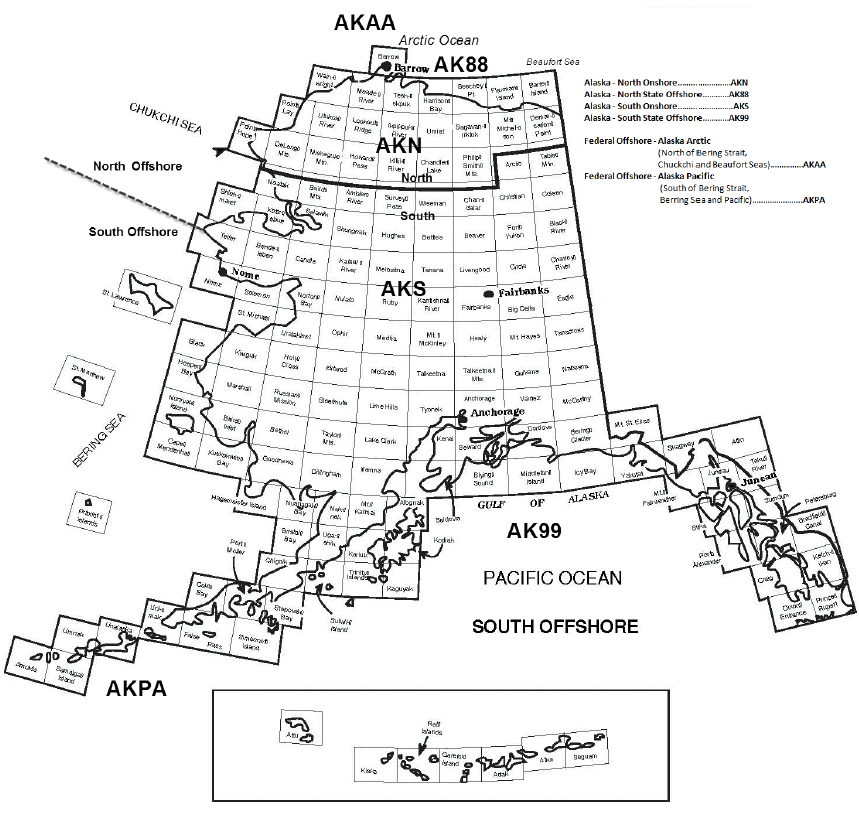
Alaska Subdivisions and U.S. Geological Report Quadrangles

Source: U.S. Energy Information Administration, Office of Oil, Gas, and Coal Supply Statistics
Subdivisions of California
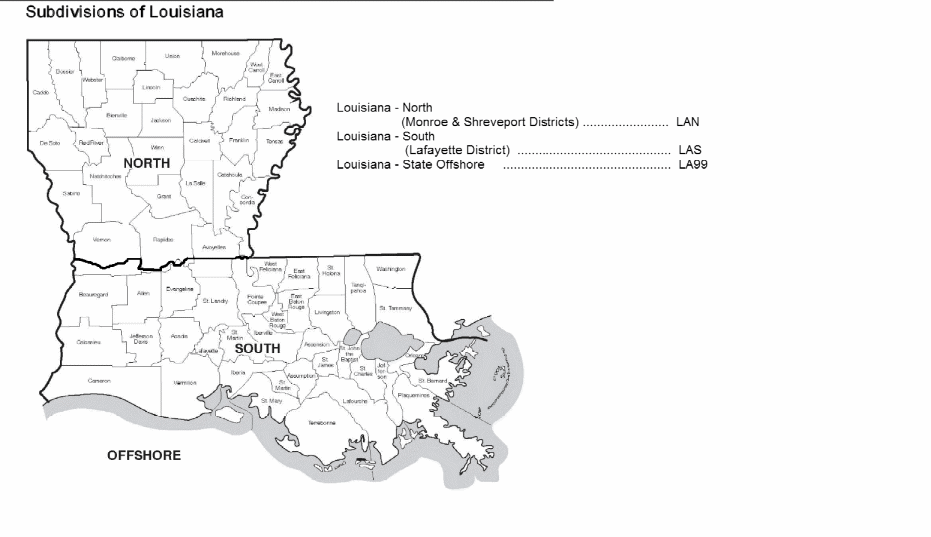
Source: U.S. Energy Information Administration, Office of Oil, Gas, and Coal Supply Statistics
Subdivisions of Louisiana
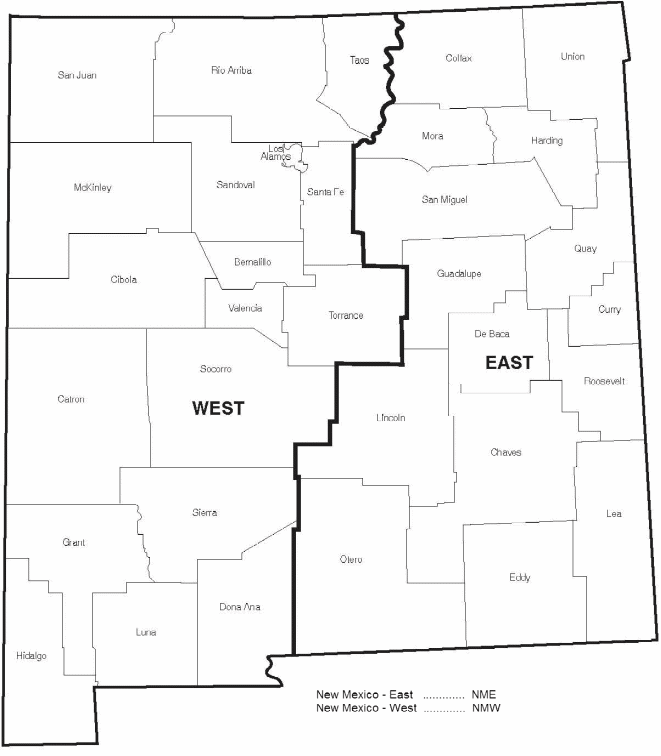
Source: U.S. Energy Information Administration, Office of Oil, Gas, and Coal Supply Statistics
Subdivisions of New Mexico
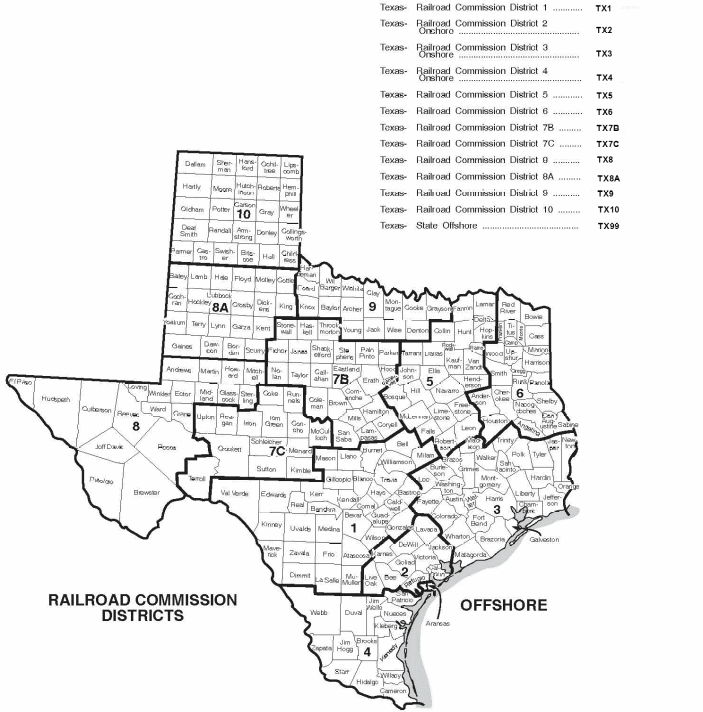
Subdivisions of Texas
Western Planning Area, Gulf of Mexico Outer Continental Shelf Region
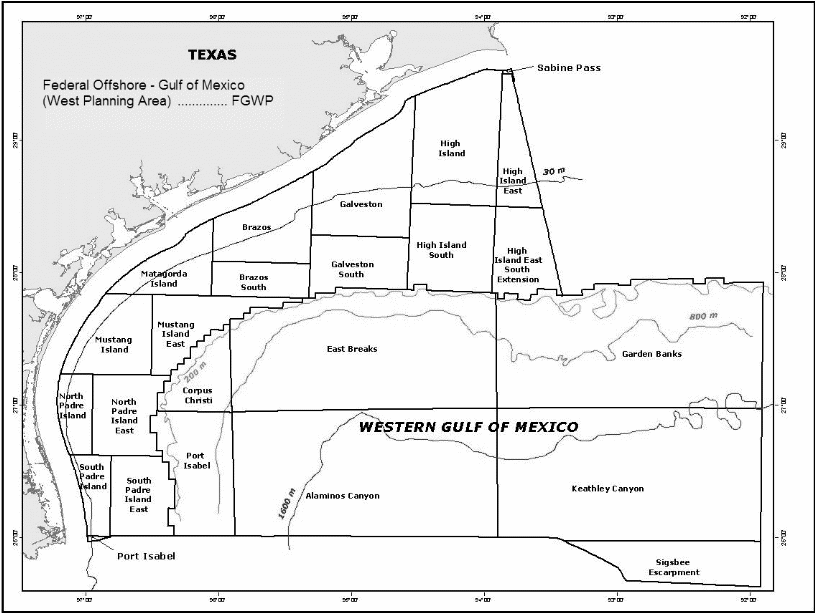
Source: U.S. Department of the Interior
Central Planning Area, Gulf of Mexico Outer Continental Shelf Region
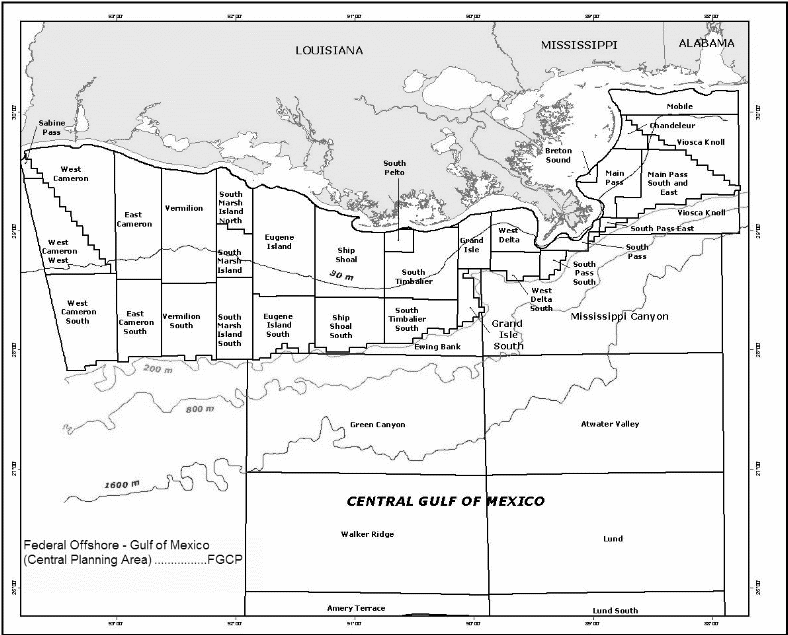
Source: U.S. Department of the Interior
Eastern Planning Area, Gulf of Mexico Outer Continental Shelf Region
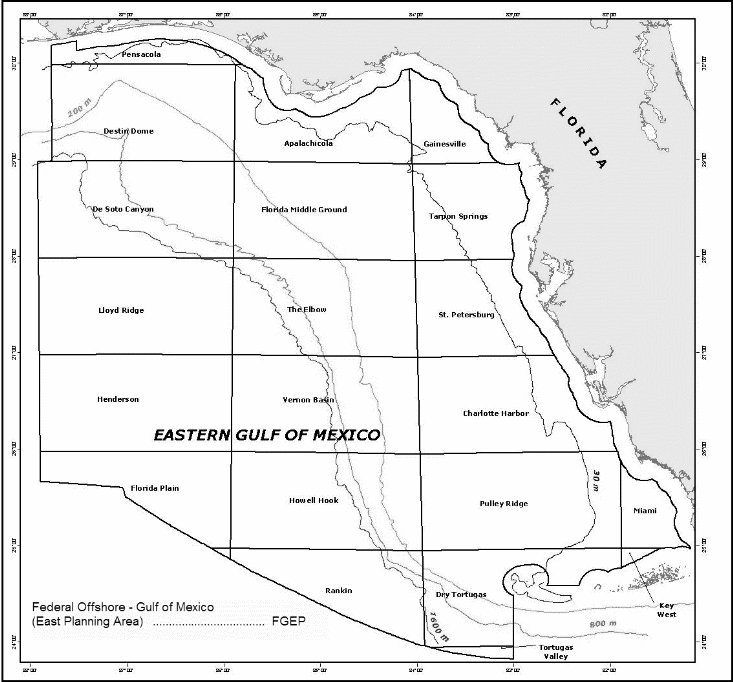
Source: U.S. Department of the Interior.
Energy Information Administration
Secure File Transfer System
Welcome to EIA’s Secure File Transfer System. Following are the instructions for sending your Excel and .Dat files to EIA by HTTPS.
Open your browser and type in the URL:
https://signon.eia.doe.gov/upload/noticeoog.jsp
The Secure File Transfer Notice to Users page will come up.
If you wish to continue, press the Accept button with your mouse. The Secure File Transfer page will come up.
You may navigate through the boxes on the page either with the tab key or with your mouse.
Type your name, company name, phone number and email address into the boxes provided. Note that the email address is required so that we can send you a confirmation of the receipt of your data.
In the yellow box, select the Browse button after File 1.
A dialog box will come up which will allow you to find the file on your hard drive or other mapped drives. Select the file with a double mouse click (or single mouse click on the file and mouse click on the Open button). The name will appear in the white box on the Secure File Transfer page. (Note that you can type in the full path of the file if you wish, but there is a greater chance of making a mistake.)
If you have other files that you want to transfer, repeat steps 6 and 7 up to four more times.
If you want to start over with the file selection, select the Reset button.
If you are ready to submit your files, select the Submit button. Please be patient; it may take a minute or two to upload your files. Do not close your browser during the upload. Wait to see the confirmation page.
A confirmation page will be displayed that will tell you the names of the files you have transferred, the confirmation number for each file, and the date and time of the transfer.
If you have more files to transfer, select the Back to Secure Upload button to return to the Secure File Transfer page. Your contact information will remain, but the file section will be empty.
Repeat steps 6-10.
When you are finished, close your browser by clicking on the X in the upper right corner.
If you have any trouble transferring your files, please call the EIA-23L Coordinator at 800-879-1470.
About Transferring Files Securely with HTTPS:
EIA is ensuring the security of your transactions by using the latest Internet security technology. The technology being used to protect your data is encryption which is the scrambling of data into a code that is unreadable to anyone who does not have the key that deciphers it. The secure hypertext transfer protocol (HTTPS) is a communications protocol designed to transfer this encrypted information between computers over the World Wide Web. All information is protected by 128-bit encryption to maintain the privacy and confidentiality of your data. The only thing you need to take advantage of strong encryption technology is a secure browser, one that supports 128-bit encryption.
201X EIA-23S Annual Report of Domestic Oil and Gas Reserves, Summary Level
| File Type | application/vnd.openxmlformats-officedocument.wordprocessingml.document |
| Author | Sara Todd |
| File Modified | 0000-00-00 |
| File Created | 2021-01-24 |
© 2025 OMB.report | Privacy Policy

